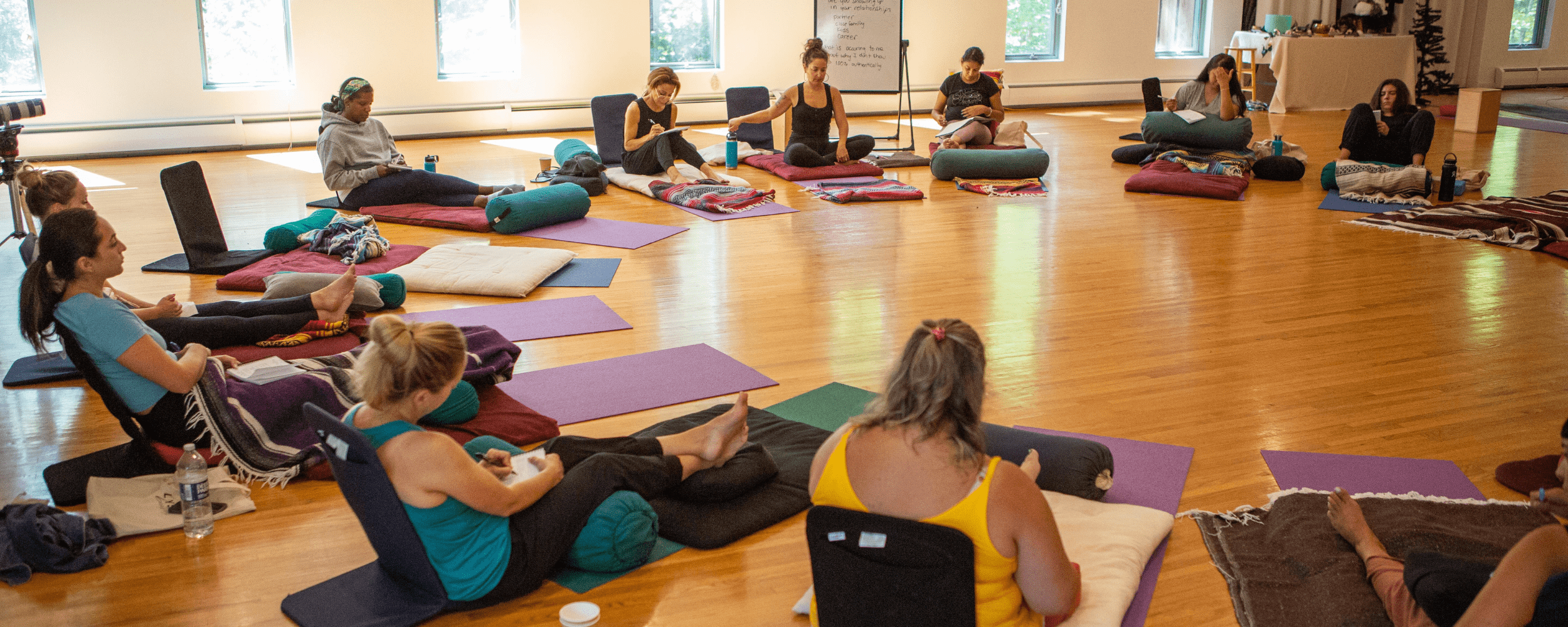By Alyse Bacine
Last updated March 2025
The Intuitive Mind: Beyond Logic to Profound Transformation
What is an Intuitive? An intuitive person perceives information through immediate knowing rather than step-by-step analysis. They naturally detect patterns, energies, and subtle cues that others miss. Intuitive people process information holistically, often experiencing physical sensations, clear mental impressions, or simply "knowing" something without being able to explain how they know it.
Intuition operates as an immediate understanding without conscious reasoning—that knowing sense that appears before logical analysis can catch up. This capacity for direct knowing exists in everyone to some degree, but for specific individuals, it functions as their primary way of perceiving and understanding the world. These are the people we recognize as intuitive.
Intuition has been revered as profound wisdom and dismissed as mere coincidence. Yet today, this natural ability is gaining recognition in spiritual circles, scientific research, business leadership, and healthcare.
Introduction to Intuition
Intuition isn't magical thinking—it's a natural cognitive process that occurs below the threshold of conscious awareness. When we refer to someone as intuitive, we're referring to their capacity to grasp information directly without the step-by-step reasoning process most people rely on.
Ancient Greeks considered intuition a form of divine insight, while Eastern philosophies viewed it as awareness beyond the physical senses. Indigenous cultures worldwide have long respected intuitive knowledge as essential for survival and healing work.
Today, intuition stands at the intersection of scientific research and practical application. People with heightened intuitive capacities often serve in roles where detecting subtle patterns proves valuable—from healthcare to counseling to various healing modalities.
Characteristics of an Intuitive
Intuitives tend to share distinctive traits that reflect their unique way of processing information:
Heightened sensitivity to environments, energies, and subtle cues
Natural pattern recognition that bypasses conscious analysis
Quick detection of incongruence between what's said and what's true
Empathic abilities that sometimes feel overwhelming
Processing information holistically rather than sequentially
Receiving knowledge through impressions, images, or direct knowing
Physical sensations that correlate with specific insights
Accurate first impressions of people and situations
These characteristics define an intuitive person who perceives reality through immediate knowing rather than sequential analysis. While linear thinkers process information like reading a map step by step, intuitive individuals experience the entire landscape simultaneously.
An Energy Healer works through this immediate knowing to identify root causes of suffering or limitation. Their perception extends beyond symptoms to the underlying patterns creating those symptoms, allowing for more comprehensive approaches to transformation.
The Science Behind Intuition
Modern research has begun validating what intuitives have experienced for millennia. The HeartMath Institute's studies demonstrate that the heart sends more signals to the brain than it receives, suggesting our bodies process information beyond conscious awareness.¹ This research helps explain the "gut feelings" and physical sensations many intuitives report during work.
Neuroscience reveals that intuitive insights activate different neural networks than analytical thinking. When making intuitive decisions, increased activity appears in the anterior cingulate and insular cortex—areas associated with integrating physical sensations, emotions, and memory.² This suggests intuition isn't random guessing but rather rapid information processing below the conscious threshold.
The enteric nervous system—our "second brain" in the gut—contains over 100 million neurons that process information independently of the conscious mind.³ This emerging science provides a physiological basis for understanding how intuitive perception works, validating what intuitive individuals have always known experientially.
These scientific findings support the effectiveness of energetic alignment techniques that incorporate intuitive insights. By accessing information through these natural neurological pathways, skilled practitioners can address complex patterns that conventional approaches might miss.
Intuition vs. Gut Feeling
Though often used interchangeably, intuition and gut feelings represent different aspects of non-analytical knowing. Gut feelings typically manifest as physical sensations—tension, relaxation, contraction—in response to situations. They represent the body's immediate reaction based on past experiences and pattern recognition.
Intuition extends beyond these physical reactions, including clear knowing that arrives without logical progression. It often incorporates visual, auditory, or kinesthetic impressions alongside the physical sensation. Someone with developed intuitive abilities recognizes the distinction between pattern-based reactions and direct knowing.
This distinction matters because effective energetic healing requires discerning between personal reactions and clear perception. An intuitive might experience a gut response to someone's energy and receive clear information about underlying patterns that are creating their current situation.
The Role of Intuition in Decision Making
Intuition proves particularly valuable in specific contexts:
Complex situations with too many variables for conscious analysis
Time-sensitive decisions requiring immediate action
Breaking established patterns to create new outcomes
Addressing subtle relational dynamics
Detecting incongruence between stated intentions and underlying truth
Research shows that experts in fields from emergency medicine to firefighting often make better decisions using intuition rather than strict analysis when under pressure.⁴ This doesn't diminish the value of analytical thinking but recognizes that different situations benefit from different cognitive approaches.
This integration of intuitive and analytical abilities represents a hallmark of effective practice for those exploring what it means to be a healer in contemporary contexts. The capacity to perceive patterns directly while maintaining critical thinking allows practitioners to address immediate symptoms and underlying causes.
Developing Intuitive Abilities
While some naturally experience strong intuition, these abilities can be developed through consistent practice:
Present-moment awareness: Regular meditation quiets the analytical mind that drowns out intuitive signals
Tracking "hits": Recording intuitive impressions and reviewing later for accuracy builds confidence
Body awareness: Paying attention to physical sensations that accompany insights develops sensory acuity
Creating mental space: Regular periods without digital distractions allow subtle perceptions to emerge
Emotional clearing: Addressing personal patterns reduces interference in intuitive reception
Understanding how to build intuitive skills involves these foundational practices plus specific techniques for perceiving others' patterns without personal biases interfering. The development process requires both strengthening intuitive perception and clearing emotional patterns that create static in reception.
The key difference between general intuition and healing intuition lies in application. While general intuition serves personal navigation, healing intuition requires perceiving patterns in others with clarity and precision. This distinction makes emotional clearing particularly important for those working with others.
Intuition in Different Cultures
Across cultures and traditions, intuition has been recognized and cultivated through various frameworks:
Indigenous shamanic practices developed specific protocols for receiving non-ordinary information
Eastern meditative traditions created systematic approaches to quieting the mind for clearer perception
Western mystical traditions incorporated intuitive practices within religious frameworks
Modern scientific approaches seek to understand intuition through neurological and psychological research
These diverse approaches share a common recognition: when adequately attuned, humans can access information beyond the five physical senses. What varies is the explanation and application of this natural capacity.
Emotional release through energy healing is recognized across these traditions include restoring energetic balance, releasing blocked patterns, and aligning with natural rhythms. While terminology differs, the underlying principles remain remarkably consistent across cultures and periods, suggesting they reflect fundamental human capacities rather than cultural constructs.
Criticisms and Misconceptions
Common criticisms of intuition include:
Dismissal as confirmation bias or selective memory
Confusion with wishful thinking or emotional reasoning
Concerns about verification through conventional methods
Assumptions that intuition claims infallibility
These criticisms often stem from misunderstanding authentic intuition. Accurate intuition doesn't claim perfect accuracy, isn't threatened by verification, and remains willing to be proven wrong. It offers additional information rather than replacing critical thinking.
The most harmful misconception treats intuition as mysterious or supernatural rather than a natural human capacity. This framing prevents serious study and application of intuitive abilities in contexts that could prove valuable.
For those considering an intuitive healing path who work intuitively, recognizing these misconceptions helps prevent common pitfalls in development and practice. Practical intuitive work requires clarity about what intuition is and isn't and commitment to ongoing practice and refinement.
Conclusion
Understanding intuition involves recognizing it as a valid form of information processing that complements rather than opposes analytical thinking. The most effective approach integrates both modes—using intuition to identify patterns and possibilities while applying analysis to verify and implement insights.
For those drawn to healing work, intuition offers a pathway to addressing the root causes of suffering rather than just managing symptoms. This approach aligns with the growing recognition that complete transformation requires addressing patterns at their source rather than focusing solely on surface manifestations.
As research provides a deeper understanding of these natural human capacities, the role of intuition in effective healing and transformation will likely continue gaining recognition. What remains consistent is that intuition, when properly developed and applied, offers valuable insights that analytical thinking alone might miss.
Frequently Asked Questions
How do I know if I'm intuitive? You may be intuitive if you frequently know things without logical explanation, sense others' emotions quickly, notice subtle patterns others miss, experience strong gut reactions that prove accurate, or receive information through sudden insights, dreams, or physical sensations.
Can intuitive abilities be developed, or are you born with them? While some naturally have stronger intuitive skills, everyone can develop intuition through meditation, mindfulness, tracking intuitive impressions, reducing distractions, and clearing emotional blockages that interfere with clear perception.
What's the difference between being psychic and being intuitive? Intuition is a natural human capacity for direct knowing and pattern recognition, while psychic abilities often refer to specific extrasensory perceptions like clairvoyance or precognition. All humans have intuition to varying degrees, while psychic abilities manifest more specifically in particular individuals.
How can intuition be valuable in everyday life? Intuition helps make complex decisions, avoid potentially harmful situations, understand others' needs and motivations, find creative solutions to problems, and detect incongruence between what people say and what's true.
Why do intuitive insights sometimes appear to be wrong? Intuitive impressions can be misinterpreted when mixed with fears, wishes, or biases. True intuition may deliver accurate information that's incorrectly analyzed or applied. Developing discernment between genuine intuition and personal projection is essential to intuitive development.
References
¹ McCraty, R., Atkinson, M., & Bradley, R. T. (2004). Electrophysiological evidence of intuition: Part 1. The surprising role of the heart. Journal of Alternative and Complementary Medicine, 10(1), 133-143.
² Volz, K. G., & von Cramon, D. Y. (2006). What neuroscience can tell about intuitive processes in the context of perceptual discovery. Journal of Cognitive Neuroscience, 18(12), 2077-2087.
³ Gershon, M. D. (1998). The second brain: A groundbreaking new understanding of nervous disorders of the stomach and intestine. HarperCollins Publishers.
⁴ Klein, G. (2008). Naturalistic decision making. Human Factors, 50(3), 456-460.
Alyse Bacine— Transformational Trauma Expert & Breathwork Practitioner
Alyse Bacine, founder of Alyse Breathes and creator of The Metamorphosis Method™, has over 24 years of breathwork experience and an extensive mental health background. She’s pioneered a methodology that uniquely bridges the gap between traditional therapy and somatic healing.
The Metamorphosis Method™ is the first comprehensive approach that combines clinical mental health expertise with advanced breathwork and energy healing. This powerful integration helps women like you break free from limiting patterns and step into your true purpose, creating lasting transformation where other approaches fail.


